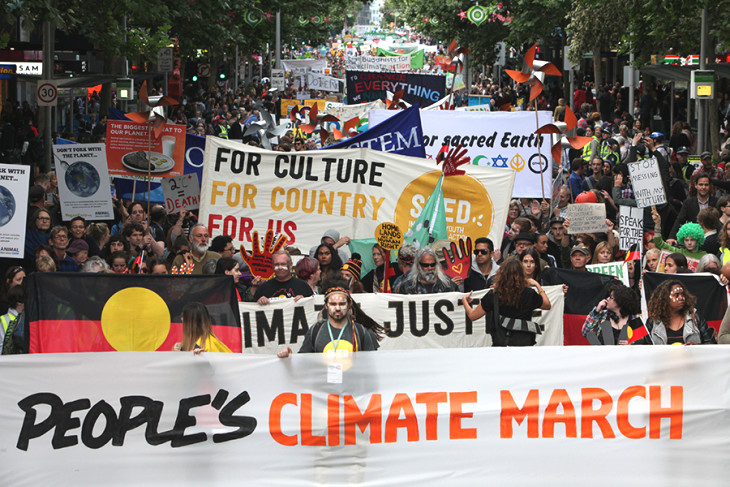
La marcia globale per il clima a Melbourne, Australia, ha dato il via alla stagione delle manifestazioni con decine di migliaia di partecipanti.
E' stata una grande spinta per chi era a Parigi: per quelli che non hanno potuto marciare, perché le marce sono state impedite per motivi di sicurezza, per quelli che accorrevano nella capitale francese per partecipare in qualità di delegati, osservatori, giornalisti, lobbisti, rappresentanti della società civile.
E 'stata davvero la più grande affluenza di cittadini mai vista, per la protezione del clima e la solidarietà. Centinaia di migliaia di persone hanno superato ogni ostacolo alla marcia. Circa 2300 eventi in 175 paesi sono stati registrati, in tutto il mondo. Forse molti altri eventi più piccoli non sono stati considerati nelle statistiche ufficiali, ma hanno contribuito ugualmente al coro globale.
Mundus maris ha partecipato all'evento a Duesseldorf
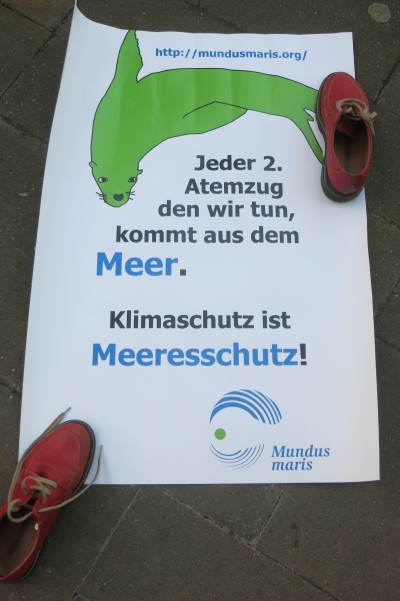 Organizzato per iniziativa delle persone già al centro della marcia per il clima del 21 settembre, il gruppo di supporto e sponsorizzazione di questo anno è cresciuto in modo incoraggiante.
Organizzato per iniziativa delle persone già al centro della marcia per il clima del 21 settembre, il gruppo di supporto e sponsorizzazione di questo anno è cresciuto in modo incoraggiante.
Con Maik Willmes, Nick Goedeking, Mattes Liebsch e il prof. dr. Gößling, il nucleo organizzativo ha saputo ispirare gli altri alla partecipazione e al coinvolgimento.
Tra gli altri sponsor vi erano una società di promozione delle energie rinnovabili e del risparmio energetico elettrico, e la cassa di risparmio locale (Stadtsparkasse).
Günter Karen-Jungen, Sindaco verde di Düsseldorf, ha offerto il suo patrocinio.
L'evento nel quartiere Bohème della capitale della Renania ha associato moderazione, brevi discorsi informativi e molta musica dal vivo, con la signora Brightside e la sua banda, oltre che ampie possibilità di discussioni tra i partecipanti. Questo il programma dell'evento:
11:00 - Benvenuto del sindaco di Dusseldorf, capitale della Renania
11:15 - Musica dal vivo
11:30 - Prof. Claus Gößling: Che cosa è il cambiamento climatico. Note sul retroscena
11:45 - Musica dal vivo
11:50 - Mattes Liebsch: Presentazione del Piano dei 10 punti - cosa posso fare io stesso
12:05 - Musica dal vivo
12:15 - Nick Goedeking: Il cambiamento climatico - Informazioni di base sulla riunione ONU di Parigi
12:30 - Musica dal vivo
12:35 - Jörg Heynkes: Il ruolo delle piccole e medie imprese nel contrastare il cambiamento climatico
12:42 - Carmela Melstroem – Cosa possono fare le piccole imprese?
12:50 - Musica dal vivo
13:00 - Prof. Claus Gößling e Mattes Liebsch: il Piano dei 10 punti - altre considerazioni
13:15 - Musica dal vivo
13:20 - Discussione con gli esperti
13:55 - Note di chiusura
 Il sindaco Karen-Jungen ha accolto i partecipanti ed espresso l'impegno del consiglio cittadino ad incrementare le misure di contenimento del cambiamento climatico in tutta la pubblica amministrazione così come nel supportare le misure di risparmio energetico adottate dai cittadini e dalle imprese.
Il sindaco Karen-Jungen ha accolto i partecipanti ed espresso l'impegno del consiglio cittadino ad incrementare le misure di contenimento del cambiamento climatico in tutta la pubblica amministrazione così come nel supportare le misure di risparmio energetico adottate dai cittadini e dalle imprese.
La parte seguente è in corso di traduzione.
A lighthouse project was the new hyper-efficient electricity plant that provided central heating as well and was billed as currently the most advanced in the world.
But the city was also investing in climate proofing its car fleet, increasing energy efficiency of public buildings and promoted practical action by citizens as well.
The watchword was - nobody can do it alone, but everybody can do something.
Prof. Dr. C. Gößling followed up on this theme and explained the physical principles behind the greenhouse effect and its initally beneficial effects on our planet's climate.
Echoing the results of the last assessment report of the Intergovernmental Panel on Climate Change (IPCC) he noted that the each of the last three decades had increased average temperatures compared to the previous one.
The CO2 emission of an "average" German was a whopping 11 tons/year (some estimates are even as high as 12.5 tons). That includes emissions not provoked by the individual directly, but arising from different services and institutions, such as health care, the military, the industrial food system etc.
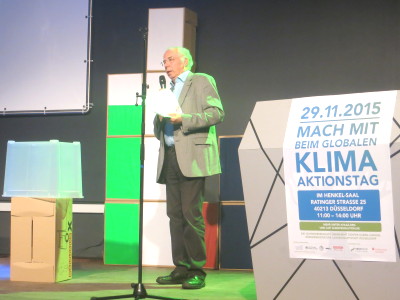 The thinning of ice shields and melting of glaciers around the world. The warming ocean has increased sea levels in the last century by 19 cm, more than in the previous 2000 years.
The thinning of ice shields and melting of glaciers around the world. The warming ocean has increased sea levels in the last century by 19 cm, more than in the previous 2000 years.
We can measure current change compared to past states. It is difficult to predict the future. Therefore, scientists develop scenarios based on different types of behaviour of people, companies and entire societies.
Strong immediate efforts to stop further CO2 emissions offer hope to keep warming at the end of this century to about 2°C as proposed to the UN Climate Summit in Paris starting tomorrow. It is worth noting that African and island countries are militating for limiting the warming to 1.5°C as their existence is otherwise in jeopardy.
However, if business continues "as usual" - as still seems to be the case despite much talk - we are heading towards a world that will be 3 to 5°C warmer on average at the end of this century.
Nobody can predict with certainty how Earth will look like. The climate models available at the moment can not describe such a regime very well.
We do know, however, that only the one degree increase experienced so far has already led to more extreme weather events, lots of damage to people and infrastructure and that tropical animals such as corals already die en masse because their temperature tolerance is exhausted.
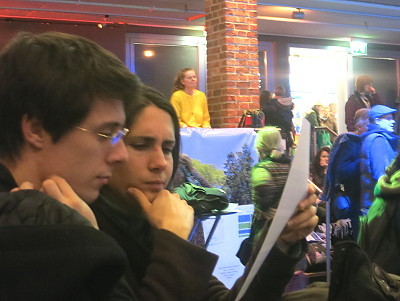 Focusing on what can and must be done to prevent warming from running totally out of control, the organisers presented a 10-point-plan for immediate action.
Focusing on what can and must be done to prevent warming from running totally out of control, the organisers presented a 10-point-plan for immediate action.
The plan addresses the four big areas of average annual CO2 emissions by German citizens:
- mobility (2.4 tons)
- consumption and food (4.5 tons)
- electricity (0.8 tons)
- heating (1.8 tons).
Advice covers suggestions such as taking more bicycle rides instead of the car, avoid air travel if possible, reduce meat consumption, chose a utility providing electricity from renewable sources, abolish the stand-by mode of household appliances, and insulate your house or appartment.
Click here to download the 10-point-plan for immediate climate action (in German).
There was plenty of opportunity to get more information about how to put these and other measures into action. We heard from Jörg Heynkes of the Chamber of Commerce that losing or gaining money makes entrepreneurs sit up and listen to what consumers want in terms of climate friendly products and services.
A children's corner offered painting and tinkering and Mrs. Brigthside and her live band lifted the spirit with a wide spectrum of music.
Catch the atmosphere by clicking on the link to the video. Click here for more info on climate solutions. All pics on this page by Cornelia E Nauen.
Virtual march in Brussels
 In Brussels security concerns led to several false starts - gathering on 29 November at noon on the central Grand Place - yes, no, yes ....
In Brussels security concerns led to several false starts - gathering on 29 November at noon on the central Grand Place - yes, no, yes ....
To play it safe, there were several smaller activities all geared to exchange about what was at stake for our future at the Paris Summit and showing solidarity not only with the victims of the Paris and Beirut attacks, but with refugees fleeing violence and destruction of their environment and with all those in need.
In one of the events, participants recalled specifically the role of the ocean for climate stabilisation and life on Earth.
Felicitas, Marcos, Marianne, Regine, Peter, Manuela, Rafa, Nadia, Dorothea.... participated in a virtual march for the climate and sent this picture.
This wonderful multigenerational initiative made a pledge to take practical steps to protect the climate through something within their means they could do in their own daily lives. An example to follow! Let it become thousands, millions doing likewise.
Youths from Senegal send their messages
Thanks to some particularly committed teachers, several school classes from Senegal worked on ideas for the UN Climate Change Conference in Paris and what would be important for a safe future for themselves and their families.
Magath Diop, Director of the Khadim School in Hann entrusted the task to a young colleague who sent some photos and the strong message from 12 year-old Fatou FALL, speaking on behalf of all kids:
Pupils of the world, let's get up against global warming. Really, this planet is heating up and that's threatening.
During the night of 30 August 2015 the dwellers living near the beach of Hann Bay in Senegal have not slept until the early hours. Indeed, the Sea, our sick neighbour, has destroyed houses, pirogues, has carried away dresses, medecins and household utensils. The following day the authorities spoke about the consequences of climate change and warming.
Dear Parents, stop the emission of greenhouse gases. We are afraid of drought, of diseases, of suffering from hunger and flooding.
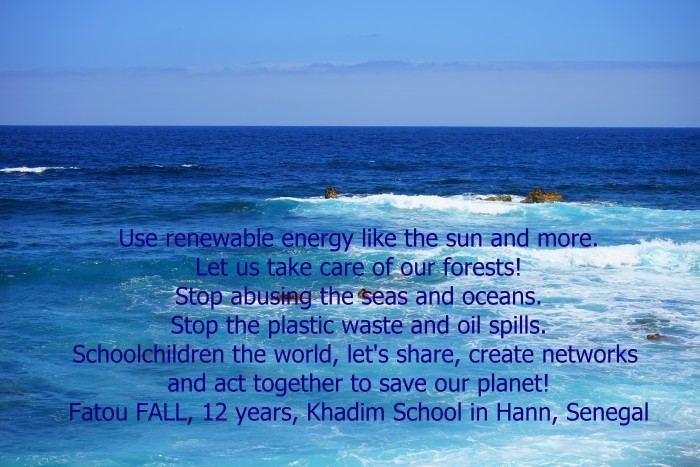
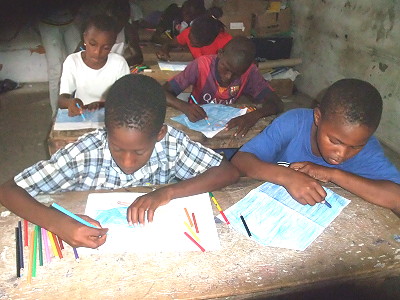 |
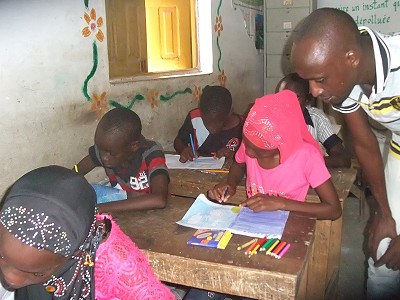 |
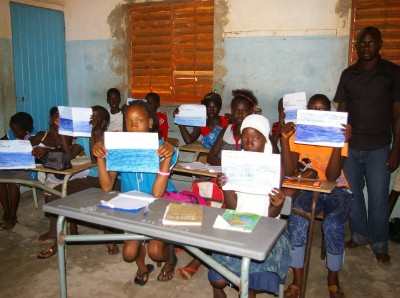 Mamadou Camara is a Teacher at the Tafsir Demba Sall 2 elementary school in Mbour.
Mamadou Camara is a Teacher at the Tafsir Demba Sall 2 elementary school in Mbour.
He is strongly committed to improve conditions for the future of his pupils and the entire community.
He sent another series of pictures with wishes and advice for the Summit.
Let these voices be heard and acted upon so that these kids have a safe future in their own country, thanks also to international cooperation and exchange.
Click here for the video with "A Sea of Ideas for the UN Climate Change Conference".
 |
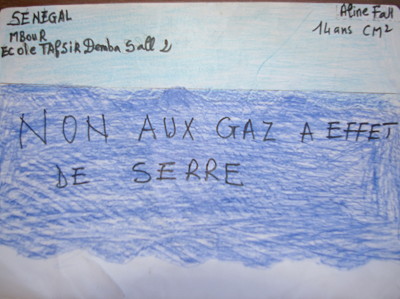 |
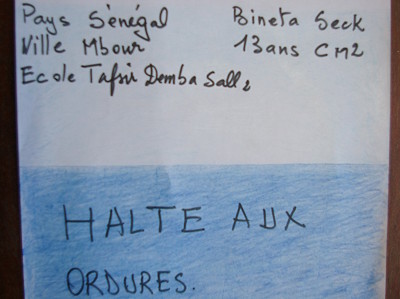 |
 |
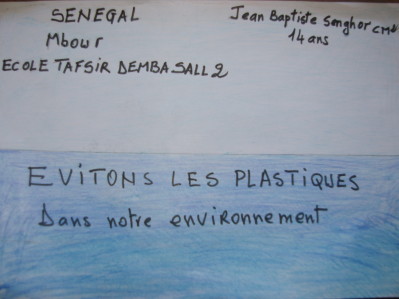 |
 |
 |
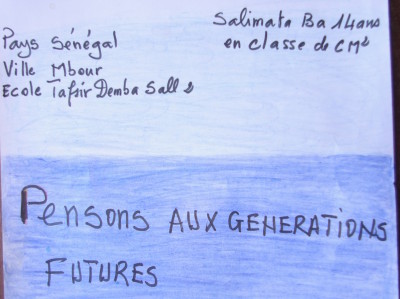 |
Il resto è storia.......

Durante le ultime ore del vertice sul clima delle Nazioni Unite, i rappresentanti ufficiali di 195 paesi hanno concordato l'obiettivo comune di mantenere il riscaldamento globale al di sotto dei 2°C alla fine di questo secolo. Gli impegni che sono stati effettuati non corrispondono ancora al bersaglio, ma i governi hanno inoltre convenuto di esaminare le prestazioni ogni cinque anni e cosi hanno aperto la porta per miglioramenti successivi.
La richiesta di una rapida fase di uscita dalla dipendenza di energia fossile era politicamente impossibile data l'opposizione dei paesi con economie basandosi prevalentemente sul petrolio e gas, come l'Arabia Saudita.
E' una vittoria delle innumerevoli persone che hanno lavorato sulla comprensione del cambiamento climatico, sulla sensibilizzazione dell'opinione pubblica, e innescando movimenti cittadini e azioni tempestive.
D'ora in poi, l'accento è posto sulla realizzazione di tutti gli impegni già presi e su come colmare le lacune per raggiungere "emissioni zero" il più velocemente possibile. Le organizzazioni della società civile di tutto il mondo farebbero bene a concentrarsi sul monitoraggio di quanto è stato effettivamente fatto e a contribuire ad ampliare e approfondire ulteriormente gli impegni. Non solo è possibile a tutti fare la loro parte, per quanto piccola, ma i grandi emettitori come l'industria aerea e degli trasporti marittimi a anche bisogno di entrare nel regime di mitigazione, dato che insieme rappresentano già circa il 6% delle emissioni globali con tendenza di aumento.
Siamo felici di aver contribuito a questo risultato incoraggiante del vertice, ma sappiamo anche che ci aspetta un sacco di duro lavoro per permettere di realizzare le grandi trasformazioni economiche e tecniche necessarie in un modo socialmente accettabile.















